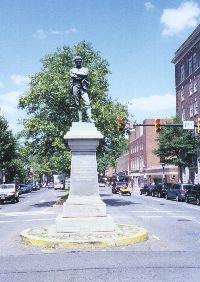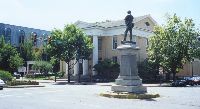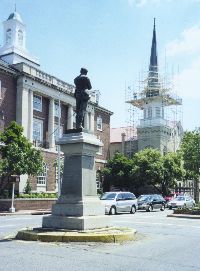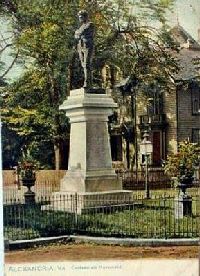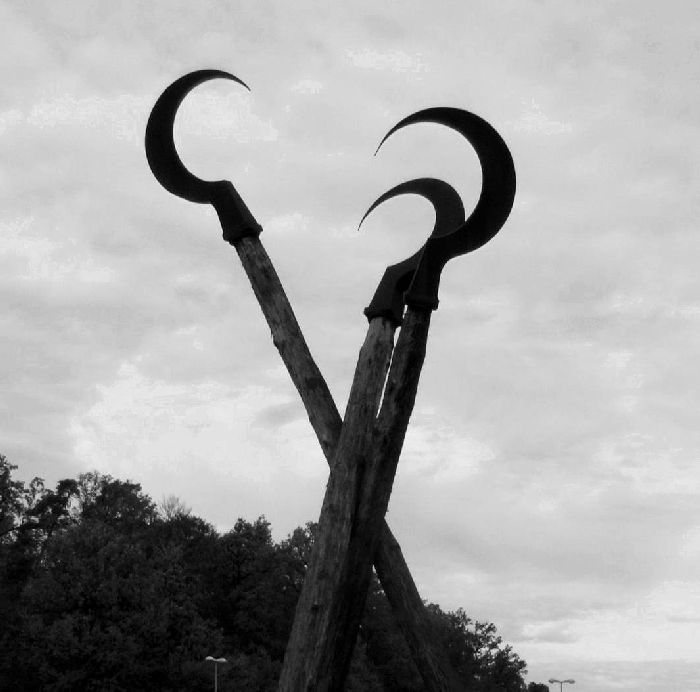Confederate "Appomattox" Memorial in Alexandria, Virginia
Pictures and text by Willard Sturgill
The sentiment engendered by the Civil War and the military occupation of Alexandria gave rise to a chapter of the United Confederate Veterans organization. In 1886 a proposal was put forth to the UCV to erect a memorial to the men of Alexandria who died in the war. A statue was commissioned based on a previously published drawing of an unarmed Confederate soldier, head bowed, observing the surrender of the Army of Northern Virginia at Appomattox Court House. On May 24th, 1889 the memorial was dedicated on the spot where Alexandria's troops had departed the city 28 years earlier. The statue portrays a Confederate soldier who faces South as if in deep contemplation. The inscription on the South face of the monument's base reads: Erected to the memory of Confederate dead of Alexandria, Va. By their Surviving Comrades, May 24th 1889. On the North side of the monument the inscription reads: They died in the consciousness of duty faithfully performed. On the West and East sides of the base were listed the names of 99 men of Alexandria who gave their lives during the war. The name of James W. Jackson, the proprietor at Marshall House, was added to the East side of the monument in 1900. Huge crowds attended the dedication ceremonies where the keynote speakers were the Governor of Virginia, former Confederate Cavalry commander and nephew of General R.E. Lee, Fitzhugh Lee, and former commander of the Confederate Army of Tennessee General Joseph E. Johnston. To ensure that the statue would not be moved at some future date, the UCV had legislation introduced into the Virginia House of Delegates which passed on January 9th, 1890 and which reads in part: And whereas it is the desire of the said Robert E. Lee camp of Confederate Veterans and also the citizens and inhabitants of said City of Alexandria that such a monument shall remain in its present position as a perpetual and lasting testimonial to the courage, fidelity and patriotism of the heroes in whose memory it was erectedů the permission so given by the said City Council of Alexandria for its erection shall not be repealed, revoked, altered, modified, or changed by any future Council or other municipal power or authority. The memorial became very popular and several copies were made and placed in various locations throughout the South until the UCV obtained a copyright in October 1892.
Alexandria's location at the southern approaches to Washington caused her to suffer during the war and geography figures prominently in the history and the placement of the "Appomattox" memorial, known locally as "The Confederate Statue". The same year that the memorial to Confederate veterans was proposed, the citizens of Alexandria also proposed the creation of a 16-mile long scenic highway connecting George Washington's home at Mount Vernon, located eight miles South of Alexandria, to Arlington eight miles northward. Congress authorized a survey in 1889 but construction did not begin until 1929. The Mount Vernon Memorial Parkway has a minimum right of way of 200 feet, except through the city of Alexandria where it narrows due to the street lay out of "Old Town". The area around the Confederate Statue measured at one time 40 by 60 feet and had a fence and ornamental gas lamps but, as traffic increased on South Washington Street, the area was reduced first in 1923 and again in 1932 when construction of the Parkway was completed.
